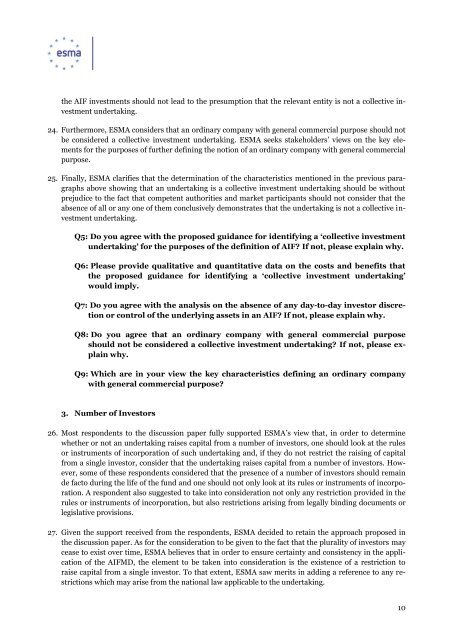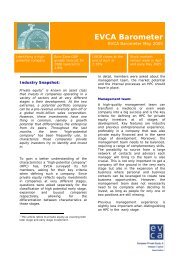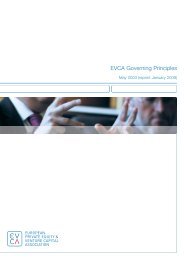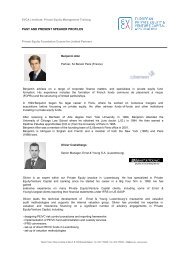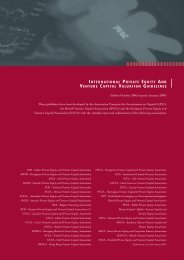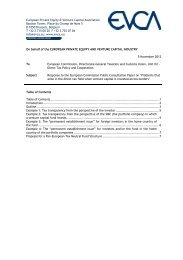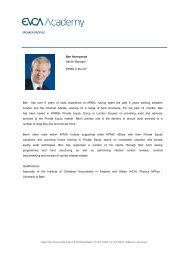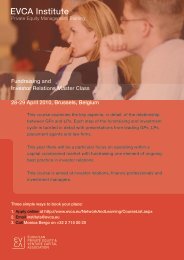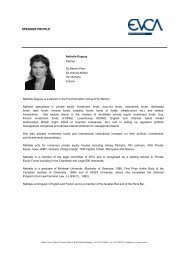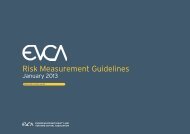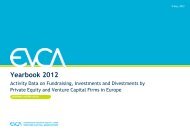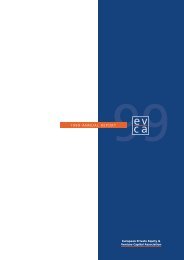Guidelines on key concepts of the AIFMD - Esma - Europa
Guidelines on key concepts of the AIFMD - Esma - Europa
Guidelines on key concepts of the AIFMD - Esma - Europa
Create successful ePaper yourself
Turn your PDF publications into a flip-book with our unique Google optimized e-Paper software.
<strong>the</strong> AIF investments should not lead to <strong>the</strong> presumpti<strong>on</strong> that <strong>the</strong> relevant entity is not a collective investmentundertaking.24. Fur<strong>the</strong>rmore, ESMA c<strong>on</strong>siders that an ordinary company with general commercial purpose should notbe c<strong>on</strong>sidered a collective investment undertaking. ESMA seeks stakeholders’ views <strong>on</strong> <strong>the</strong> <strong>key</strong> elementsfor <strong>the</strong> purposes <strong>of</strong> fur<strong>the</strong>r defining <strong>the</strong> noti<strong>on</strong> <strong>of</strong> an ordinary company with general commercialpurpose.25. Finally, ESMA clarifies that <strong>the</strong> determinati<strong>on</strong> <strong>of</strong> <strong>the</strong> characteristics menti<strong>on</strong>ed in <strong>the</strong> previous paragraphsabove showing that an undertaking is a collective investment undertaking should be withoutprejudice to <strong>the</strong> fact that competent authorities and market participants should not c<strong>on</strong>sider that <strong>the</strong>absence <strong>of</strong> all or any <strong>on</strong>e <strong>of</strong> <strong>the</strong>m c<strong>on</strong>clusively dem<strong>on</strong>strates that <strong>the</strong> undertaking is not a collective investmentundertaking.Q5: Do you agree with <strong>the</strong> proposed guidance for identifying a ‘collective investmentundertaking’ for <strong>the</strong> purposes <strong>of</strong> <strong>the</strong> definiti<strong>on</strong> <strong>of</strong> AIF? If not, please explain why.Q6: Please provide qualitative and quantitative data <strong>on</strong> <strong>the</strong> costs and benefits that<strong>the</strong> proposed guidance for identifying a ‘collective investment undertaking’would imply.Q7: Do you agree with <strong>the</strong> analysis <strong>on</strong> <strong>the</strong> absence <strong>of</strong> any day-to-day investor discreti<strong>on</strong>or c<strong>on</strong>trol <strong>of</strong> <strong>the</strong> underlying assets in an AIF? If not, please explain why.Q8: Do you agree that an ordinary company with general commercial purposeshould not be c<strong>on</strong>sidered a collective investment undertaking? If not, please explainwhy.Q9: Which are in your view <strong>the</strong> <strong>key</strong> characteristics defining an ordinary companywith general commercial purpose?3. Number <strong>of</strong> Investors26. Most resp<strong>on</strong>dents to <strong>the</strong> discussi<strong>on</strong> paper fully supported ESMA’s view that, in order to determinewhe<strong>the</strong>r or not an undertaking raises capital from a number <strong>of</strong> investors, <strong>on</strong>e should look at <strong>the</strong> rulesor instruments <strong>of</strong> incorporati<strong>on</strong> <strong>of</strong> such undertaking and, if <strong>the</strong>y do not restrict <strong>the</strong> raising <strong>of</strong> capitalfrom a single investor, c<strong>on</strong>sider that <strong>the</strong> undertaking raises capital from a number <strong>of</strong> investors. However,some <strong>of</strong> <strong>the</strong>se resp<strong>on</strong>dents c<strong>on</strong>sidered that <strong>the</strong> presence <strong>of</strong> a number <strong>of</strong> investors should remainde facto during <strong>the</strong> life <strong>of</strong> <strong>the</strong> fund and <strong>on</strong>e should not <strong>on</strong>ly look at its rules or instruments <strong>of</strong> incorporati<strong>on</strong>.A resp<strong>on</strong>dent also suggested to take into c<strong>on</strong>siderati<strong>on</strong> not <strong>on</strong>ly any restricti<strong>on</strong> provided in <strong>the</strong>rules or instruments <strong>of</strong> incorporati<strong>on</strong>, but also restricti<strong>on</strong>s arising from legally binding documents orlegislative provisi<strong>on</strong>s.27. Given <strong>the</strong> support received from <strong>the</strong> resp<strong>on</strong>dents, ESMA decided to retain <strong>the</strong> approach proposed in<strong>the</strong> discussi<strong>on</strong> paper. As for <strong>the</strong> c<strong>on</strong>siderati<strong>on</strong> to be given to <strong>the</strong> fact that <strong>the</strong> plurality <strong>of</strong> investors maycease to exist over time, ESMA believes that in order to ensure certainty and c<strong>on</strong>sistency in <strong>the</strong> applicati<strong>on</strong><strong>of</strong> <strong>the</strong> <strong>AIFMD</strong>, <strong>the</strong> element to be taken into c<strong>on</strong>siderati<strong>on</strong> is <strong>the</strong> existence <strong>of</strong> a restricti<strong>on</strong> toraise capital from a single investor. To that extent, ESMA saw merits in adding a reference to any restricti<strong>on</strong>swhich may arise from <strong>the</strong> nati<strong>on</strong>al law applicable to <strong>the</strong> undertaking.10


